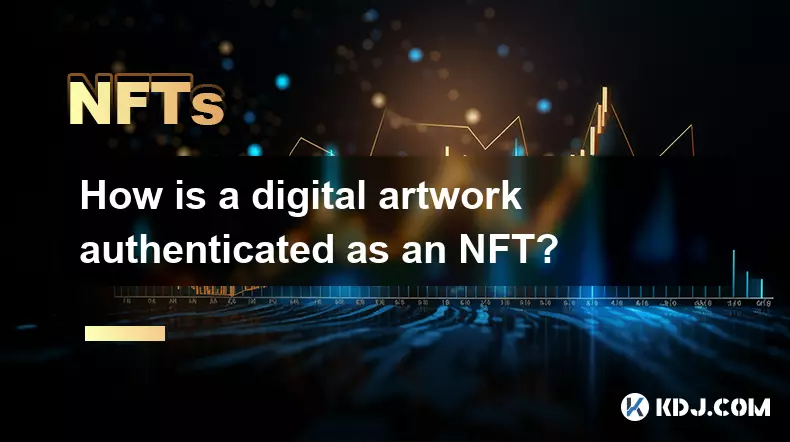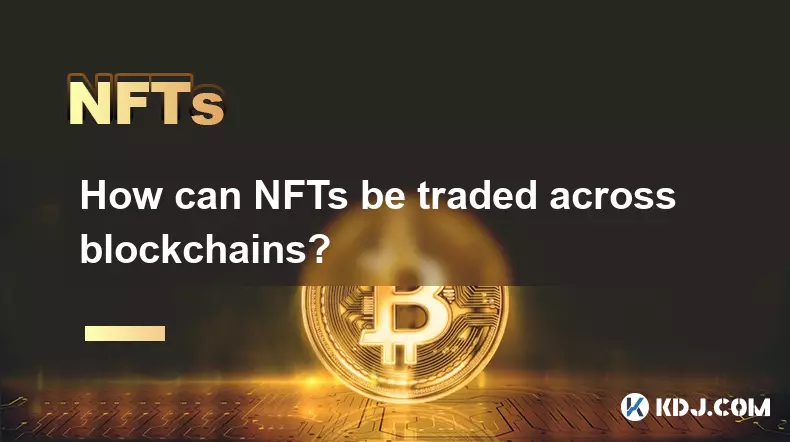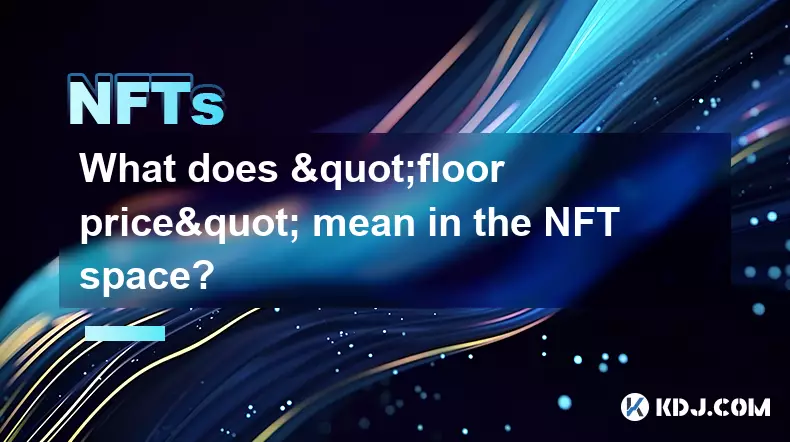-
 bitcoin
bitcoin $109523.663807 USD
-0.13% -
 ethereum
ethereum $4019.526508 USD
2.06% -
 tether
tether $1.000482 USD
0.00% -
 xrp
xrp $2.776815 USD
0.18% -
 bnb
bnb $958.942396 USD
0.12% -
 solana
solana $204.294698 USD
3.84% -
 usd-coin
usd-coin $0.999693 USD
0.00% -
 dogecoin
dogecoin $0.232115 USD
2.09% -
 tron
tron $0.338028 USD
0.84% -
 cardano
cardano $0.790920 USD
1.50% -
 hyperliquid
hyperliquid $44.871443 USD
5.60% -
 ethena-usde
ethena-usde $1.000322 USD
0.04% -
 chainlink
chainlink $21.034165 USD
2.60% -
 avalanche
avalanche $28.794831 USD
-0.54% -
 stellar
stellar $0.360466 USD
1.24%
How is a digital artwork authenticated as an NFT?
An NFT’s authenticity relies on blockchain-verified ownership, immutable metadata, and cryptographic proof of origin, ensuring each digital asset is unique and traceable to its creator.
Sep 22, 2025 at 02:36 pm

Understanding the Basics of NFT Authentication
1. An NFT, or non-fungible token, is a unique digital identifier stored on a blockchain that certifies ownership and authenticity of a specific digital asset, such as artwork. Unlike fungible tokens like Bitcoin, each NFT has distinct properties that cannot be exchanged on a one-to-one basis.
2. The authentication process begins when an artist or creator mints their digital artwork onto a blockchain. This minting process involves uploading the file—often in formats like JPEG, PNG, or MP4—and generating a smart contract that contains metadata describing the artwork, including title, creator, timestamp, and sometimes even a link to the actual file.
3. Once minted, the NFT is assigned a unique token ID and recorded on a public ledger. This ensures transparency and immutability, meaning no one can alter the record of ownership or creation without network consensus.
4. The blockchain used—such as Ethereum, Solana, or Polygon—plays a critical role in maintaining the integrity of the NFT. Each transaction involving the NFT, from sale to transfer, is permanently logged and accessible to anyone, reinforcing trust in its authenticity.
5. The cryptographic signature embedded during minting acts as a digital fingerprint, confirming the legitimacy of the artwork and proving it originated from the claimed creator.
The Role of Metadata and File Storage
1. While the NFT itself resides on the blockchain, the actual digital artwork is typically not stored directly on-chain due to size and cost constraints. Instead, a URI (Uniform Resource Identifier) within the NFT’s metadata points to where the file is hosted—commonly on decentralized systems like IPFS (InterPlanetary File System) or centralized servers.
2. When using IPFS, the file is given a content hash based on its data. Any change to the image alters this hash, making tampering detectable. This strengthens authenticity by ensuring the artwork linked to the NFT remains unchanged.
3. Some NFT projects embed full artwork data directly into the smart contract, known as on-chain art. Though more secure and permanent, this method is expensive and technically complex, limiting its use to simpler or generative artworks.
4. Verifying that the metadata is immutable—meaning it cannot be altered after minting—is essential for long-term authentication. Projects using locked metadata provide stronger guarantees of provenance.
5. Buyers should check whether the NFT uses dynamic or static metadata. Dynamic metadata allows updates to attributes or links, which could risk authenticity if misused, while static metadata ensures permanence.
Provenance and Creator Verification
1. Authenticity also depends on verifying the identity of the creator. Reputable marketplaces like OpenSea, Foundation, or SuperRare often implement verification processes for artists, reducing the risk of impersonation.
2. Verified profiles with social media links, official websites, or prior sales history help establish credibility. Collectors frequently cross-reference external sources to confirm an artist's involvement.
3. Some platforms integrate cryptographic signing tools that allow creators to sign messages proving control over the wallet that minted the NFT. This adds another layer of trust beyond just wallet ownership.
4. Community reputation plays a significant role. Artists with established followings and consistent output are less likely to produce fraudulent NFTs, making community recognition a de facto authentication mechanism.
5. A legitimate NFT will have a clear, traceable chain of creation—from the minting wallet to verified artist accounts—allowing collectors to audit its origin independently.
Frequently Asked Questions
What happens if the server hosting the NFT image goes offline?If the artwork is hosted on a centralized server and the link breaks, the NFT may point to a missing file, though the token still exists on-chain. This is why decentralized storage like IPFS is preferred—it preserves availability through distributed nodes.
Can someone copy an NFT artwork and sell it as their own?While others can download or screenshot the image, they cannot replicate the original NFT’s blockchain record. Only the authentic token carries verifiable ownership and provenance. Unauthorized copies lack the valid smart contract and transaction history.
How do I verify an NFT’s authenticity before purchasing?Check the creator’s wallet address against their official profile, review the minting transaction on a blockchain explorer, ensure metadata is locked, and confirm usage of decentralized storage. Trusted marketplaces also flag verified collections.
Does owning an NFT grant copyright to the artwork?Not necessarily. Purchasing an NFT typically grants ownership of the token and associated digital file but does not automatically transfer copyright. Licensing terms vary by project—some allow commercial use, others restrict it entirely.
Disclaimer:info@kdj.com
The information provided is not trading advice. kdj.com does not assume any responsibility for any investments made based on the information provided in this article. Cryptocurrencies are highly volatile and it is highly recommended that you invest with caution after thorough research!
If you believe that the content used on this website infringes your copyright, please contact us immediately (info@kdj.com) and we will delete it promptly.
- Sleep Token's Macabre Metal: A Ritualistic Rise to Rock Stardom
- 2025-09-27 22:25:15
- BlockchainFX: Is This Presale the Next Binance?
- 2025-09-27 22:25:15
- ORDER Token's Binance Listing Ignites Crypto Rally: What Traders Need to Know
- 2025-09-27 22:30:01
- Ethereum ETFs Feel the Heat: Investors Exit as Staking Approval Looms?
- 2025-09-27 22:30:01
- Crypto Presales & Meme Coins: Hunting for the Next 100x Opportunity
- 2025-09-27 22:30:01
- Cardano (ADA) Price Prediction: Bullish Scenarios and Market Dynamics
- 2025-09-27 22:30:16
Related knowledge

How can I determine the authenticity of an NFT project?
Sep 23,2025 at 05:18pm
Understanding the Project Team and Their Background1. Research the identities of the team members behind the NFT project. Verified social media profil...

What's the difference between NFTs and traditional collectibles?
Sep 19,2025 at 12:55pm
Digital Ownership and Provenance1. NFTs are built on blockchain technology, which ensures transparent and immutable records of ownership. Every transa...

How can NFTs be traded across blockchains?
Sep 19,2025 at 12:00pm
Understanding Cross-Chain NFT Trading1. Non-fungible tokens (NFTs) are digital assets that represent ownership of unique items on a blockchain. Origin...

How is NFT rarity calculated?
Sep 18,2025 at 07:54pm
Understanding NFT Rarity Metrics1. NFT rarity is determined by analyzing the uniqueness of individual traits within a collection. Each NFT typically c...

What does "floor price" mean in the NFT space?
Sep 22,2025 at 06:36am
Floor Price: A Core Metric in the NFT Marketplace1. The term floor price refers to the lowest current asking price for any item within a specific NFT ...

How do NFTs help content creators?
Sep 18,2025 at 08:00am
NFTs Empower Creators with Ownership and Monetization1. NFTs provide content creators with verifiable ownership of their digital works, ensuring authe...

How can I determine the authenticity of an NFT project?
Sep 23,2025 at 05:18pm
Understanding the Project Team and Their Background1. Research the identities of the team members behind the NFT project. Verified social media profil...

What's the difference between NFTs and traditional collectibles?
Sep 19,2025 at 12:55pm
Digital Ownership and Provenance1. NFTs are built on blockchain technology, which ensures transparent and immutable records of ownership. Every transa...

How can NFTs be traded across blockchains?
Sep 19,2025 at 12:00pm
Understanding Cross-Chain NFT Trading1. Non-fungible tokens (NFTs) are digital assets that represent ownership of unique items on a blockchain. Origin...

How is NFT rarity calculated?
Sep 18,2025 at 07:54pm
Understanding NFT Rarity Metrics1. NFT rarity is determined by analyzing the uniqueness of individual traits within a collection. Each NFT typically c...

What does "floor price" mean in the NFT space?
Sep 22,2025 at 06:36am
Floor Price: A Core Metric in the NFT Marketplace1. The term floor price refers to the lowest current asking price for any item within a specific NFT ...

How do NFTs help content creators?
Sep 18,2025 at 08:00am
NFTs Empower Creators with Ownership and Monetization1. NFTs provide content creators with verifiable ownership of their digital works, ensuring authe...
See all articles









































































